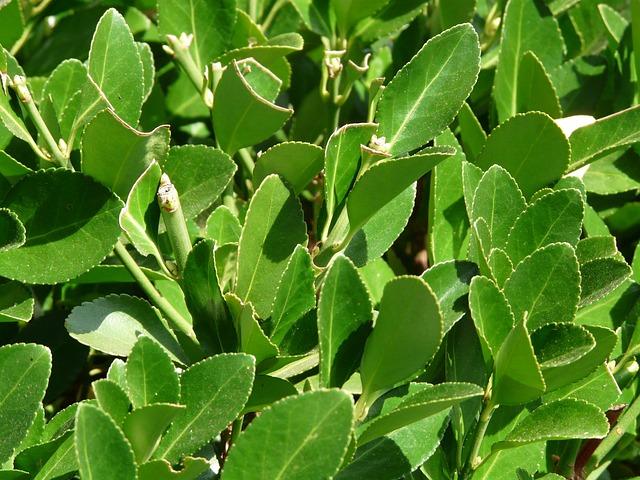The waxy leaf bush is an indoor plant that is known for its glossy, green leaves. This plant is native to Africa and Asia, and is often used as a houseplant in these regions. The waxy leaf bush is a popular plant because it is easy to care for and it does not require a lot of light or water.
This plant can grow in a variety of different climates, but it prefers warm, humid conditions. The waxy leaf bush is a fast-growing plant, and it can reach up to 6 feet in height. It is not known for its flowers, but the leaves of the waxy leaf bush are beautiful and make a great addition to any home.

Credit: Pexels
Hence, if you’re looking for a plant that will thrive in your garden, the waxy leaf bush is a great option. This blog post will enlighten you on how best you can utilize waxy leaf bush in your garden.
The History Of The Waxy Leaf Bush
The Waxy Leaf Bush is a plant that is native to the tropical regions of Africa. It was first discovered by European explorers in the early 1800s. The plant is a member of the family Euphorbiaceae, which includes plants such as the poinsettia and the rubber tree
The Waxy Leaf Bush is a member of the genus Euphorbia, which includes over 2,000 species of plants. The Waxy Leaf Bush is a succulent, that is, it stores water in its leaves. This makes it a drought-tolerant plant that can survive in dry climates. The Waxy Leaf Bush is a popular houseplant because it is easy to care for and does not require a lot of water.
The waxy leaf bush has a long history in African folklore. It is said to be a plant that can bring good luck. It is also said to be a plant that can help to ward off evil spirits. So, it is often used in magical spells and rituals.
The Waxy Leaf Bush got its name from the waxy coating on its leaves. This coating helps the plant to retain water. The leaves of the Waxy Leaf Bush are green, but they can also be red, pink, or purple. The plant produces small, white flowers. The Waxy Leaf Bush is not poisonous, but it can cause skin irritation if you come into contact with the sap.
Likewise, it is a hardy plant that can tolerate a wide range of conditions. However, it does best in warm, humid environments. If you live in a cold climate, you can grow the Waxy Leaf Bush indoors. The plant-like to be indirect sunlight, so it is best to grow it in a shady spot. The Waxy Leaf Bush can be propagated from stem cuttings.
The Benefits Of A Waxy Leaf Bush
The benefits of a waxy leaf bush are many.

- The leaves of the bush are coated in a waxy substance that helps to protect them from the elements. That is, the leaves will stay healthy and green for longer, providing your garden with a more consistent source of greenery.
- Another benefit of the waxy leaf bush is that it is relatively low-maintenance. Since the leaves are protected from the elements, they do not require as much watering or other care as other plants in your garden.
- The waxy leaf bush can also help to improve the drainage in your garden.
- When the leaves of the waxy leaf bush fall off, they create a natural mulch that can help to keep the soil moist and cool. The mulch will also help to keep weeds from growing in your garden.
- Finally, the waxy leaf bush can add some visual interest to your garden. The glossy, green leaves can help to brighten up a space, and the bush can add some texture and contrast to other plants in your garden. If you’re looking for a plant that will add some visual interest to your space, the waxy leaf bush is a great option.
The Different Types Of Waxy Leaf Bushes
1. Camellia bush.
Credit: Pexels
This bush has glossy, dark green leaves and produces white or pink flowers. The Camellia bush is an evergreen, meaning it will keep its leaves all year round. This bush is native to Asia and is often used as an ornamental plant in gardens.
2. Holly bush.
This bush has glossy, dark green leaves and produces white or red berries. The Holly bush is also evergreen and is native to Europe. Holly bushes are often used as ornamental plants or as hedges.
3. The Ivy bush.
This bush has glossy, dark green leaves and produces small, white flowers. The Ivy bush is a deciduous bush, meaning it will lose its leaves in the winter. Ivy bushes are native to Europe and are often used as ornamental plants or as ground cover.
Each of these types of waxy leaf bushes has its own unique benefits. All three types of bushes are low-maintenance and easy to care for. They are all also drought-tolerant, meaning they can survive in dry conditions.
How To Propagate A Waxy Leaf Bush
To propagate a waxy leaf bush, you will need to take a cutting from an existing bush. The best time to do this is in late spring or early summer.
- Use a sharp knife or pruning shears to take a 6-8 inch cutting from a healthy branch of the bush. Make sure that the cutting has at least 2-3 leaves on it.
- Remove the bottom leaves from the cutting, and dip the cut end into the rooting hormone.
- Plant the cutting in a pot filled with a well-draining potting mix. Water the soil lightly, and place the pot in a warm, sunny location.
- Keep the soil moist, but not wet, and in 4-6 weeks, you should see new growth. Once the new growth appears, you can transplant the bush into your garden.
How To Care For A Waxy Leaf Bush
Assuming you have already planted your waxy leaf bush, here are some tips on how to care for it:
- Water regularly. Waxy leaf bushes need to be kept moist, but not waterlogged. Water them deeply about once a week, and more frequently if the weather is hot and dry.
- Feed monthly. Use a balanced fertilizer such as 10-10-10, and apply it according to the manufacturer’s instructions.
- Prune as needed. Waxy leaf bushes can be pruned to shape them or to remove any dead or damaged branches.
- Protect from pests. Waxy leaf bushes are susceptible to pests such as aphids and scale insects. Inspect them regularly and treat them with an appropriate insecticide if necessary.
- Watch for diseases. Waxy leaf bushes can be affected by diseases such as powdery mildew and leaf spot. Treat early with a fungicide if needed.
Pests And Diseases Of A Waxy Leaf Bush
Pests and diseases can be a big problem for gardens, and the waxy leaf bush is no exception. There are a few pests and diseases that are particularly troublesome for this plant, so it’s important to be on the lookout for them.
-
Aphid
One of the most common pests that affect the waxy leaf bush is the aphid. Aphids are small, sap-sucking insects that can cause a lot of damage to plants. They can cause the leaves to curl and deform, and can also lead to a decrease in plant growth. If you see aphids on your waxy leaf bush, you should try to remove them as soon as possible.
-
Whitefly
Another pest that can be a problem for the waxy leaf bush is the whitefly. Whiteflies are small, white insects that feed on the sap of plants. They can cause the leaves of the plant to turn yellow and stunt the plant’s growth. If you see whiteflies on your waxy leaf bush, you should try to remove them as soon as possible.
Diseases
-
Powdery mildew
One of the most common is powdery mildew. Powdery mildew is a white, powdery fungus that grows on the leaves of plants. It can cause the leaves to turn yellow and drop off, and can also stunt the plant’s growth. If you see powdery mildew on your waxy leaf bush, you should try to remove it as soon as possible.
-
Root rot
Another disease that can affect the waxy leaf bush is root rot. Root rot is a condition that can be caused by a number of different fungi. It can cause the roots of the plant to rot and the plant to die.
Bonus Tips
- Waxy leaf bush can be used as a decoration in your home.
- You can use waxy leaf bush to make a natural air freshener.
- You can use the leaves of waxy leaf bush to make a natural insect repellent.
- Waxy leaf bushes can be used in the garden as a ground cover.
Frequently Asked Questions
- What are the benefits of using a waxy leaf bush in my garden?
Waxy leaf bushes can offer many benefits to your garden. As mentioned above, they can help to control weeds, retain moisture, and add nutrients to the soil. Additionally, waxy leaf bushes can help to protect other plants in your garden from pests and diseases.
- How do I care for a waxy leaf bush?
Caring for a waxy leaf bush is relatively easy. These plants are generally low-maintenance and don’t require a lot of care. However, it is important to water your waxy leaf bush regularly, as they are susceptible to drought. Additionally, you should fertilize your waxy leaf bush every few months to ensure that it remains healthy.
- What are the best conditions for growing a waxy leaf bush?
Waxy leaf bushes prefer warm, humid conditions. They should be planted in well-drained soil that is rich in organic matter. Additionally, waxy leaf bushes should be given plenty of space to grow, as they can spread quickly.
- Are there any pests or diseases that affect waxy leaf bushes?
There are a few pests and diseases that can affect waxy leaf bushes. These include scale insects, aphids, and root rot. However, these problems can generally be controlled with proper care and treatment.
- Where can I buy a waxy leaf bush?
Waxy leaf bushes are available at many nurseries and garden centers. You can also purchase them online from a variety of retailers.
Conclusion
If you’re looking for a bush that can help your garden grow, the waxy leaf bush is a great option. This bush is known for its ability to help other plants grow, so if you’re looking to add some greenery to your garden, this is a good option. The waxy leaf bush is also easy to care for, so you won’t have to spend a lot of time maintaining it.